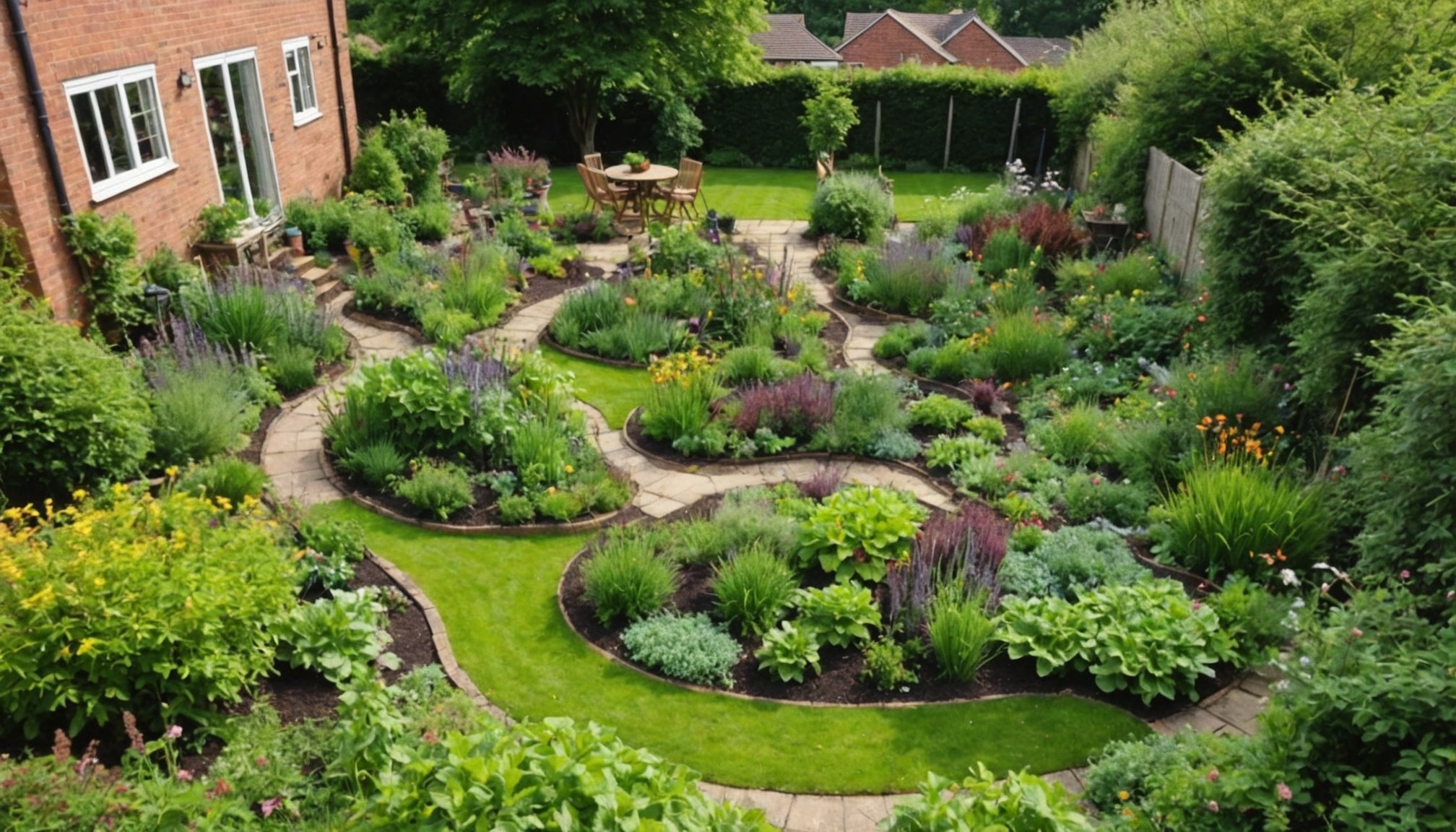Understanding Permaculture Principles
Permaculture design principles form the backbone of sustainable gardening. These principles emphasise working harmoniously with nature to establish ecological strategies that foster abundant growth while preserving resources. One of the core elements in permaculture is the principle of observation and interaction. Before planting, it is crucial to study your garden’s characteristics: sunlight patterns, wind directions, and existing wildlife. By doing so, you can make informed decisions that enhance the productivity of your garden.
Urban gardening can particularly benefit from permaculture. Despite space constraints, these principles can aid in maximizing the available area. For instance, vertical planting leverages limited space effectively while creating habitats for beneficial insects.
A lire également : Ultimate Guide to the Best Mulching Techniques for Weed Control in UK Flower Beds
To create a self-sustaining garden, focus on fostering natural relationships and synergies among plants. Companionship between different species can deter pests naturally and improve soil health, reducing the need for external inputs. For example, integrating legumes enhances nitrogen levels in the soil, benefitting neighbouring plants.
In essence, embracing permaculture design principles helps establish a balanced system that not only supports plant life but also contributes to environmental well-being. It’s an approach that turns gardening into a proactive dialogue with nature, ensuring sustainability and resilience.
Cela peut vous intéresser : Top Native UK Plants That Draw Beneficial Insects for Effective Organic Pest Management
Space-Saving Techniques for Permaculture Gardens
When faced with limited space, vertical gardening emerges as a brilliant solution. It allows you to make use of vertical space by growing plants on trellises, walls, and other structures, thus maximizing growth area. Beyond the ordinary container gardening, which allows flexibility and mobility in plant arrangement, vertical setups can support a diverse range of plants in small areas.
Companion planting is another valuable technique, where certain plant combinations can optimize growth by enhancing their neighbors. For instance, pairing tomatoes with basil not only saves space but also improves flavor and helps ward off pests. Companion planting can lead to a more productive garden without needing additional land.
Layering and stacking techniques further extend space-saving capabilities. By planting in layers, you can have ground-level growth with taller plants or vegetables in the back, creating a tiered effect. This technique is particularly useful in small gardens where every inch counts.
For a thriving permaculture garden, blending these strategies— vertical gardening, companion planting, and layered planting—can unlock the potential of any small space, promoting plant health and biodiversity while maximizing yield. Embrace these methods to transform your gardening experience and achieve more with less space.
Selecting Plants for the UK Climate
Choosing the right plants for a suburban permaculture garden in the UK requires understanding both the climate and local biodiversity. In this context, incorporating UK native plants offers several benefits. They are naturally adapted to the local environment, making them resilient to the climate shifts typical of the area. This reduces the need for external inputs such as fertilisers or pesticides. Furthermore, native plants play a crucial role in sustaining local ecosystems by providing habitat and food for indigenous wildlife.
Hardy vegetables are also excellent choices for these gardens. Varieties like kale, carrots, and broccoli can thrive, offering ample seasonal produce. Their resilience to colder temperatures makes them suitable for the UK climate.
Planting and harvesting must align with the region’s distinct seasons. Spring is ideal for sowing cool-weather crops like peas, while summer provides the best conditions for warm-season crops like beans. Meanwhile, autumn can be used for planting winter crops like cabbages.
By integrating climate-resistant flora, gardeners can create a more sustainable and rewarding growing environment, maximising productivity and fostering a robust ecosystem. Through careful selection, UK gardeners can enjoy vibrant, enduring gardens all year round.
Designing Your Permaculture Garden Layout
Creating an efficient garden layout design involves more than just placing plants in the ground. A well-thought-out permaculture zones strategy is essential for optimal results. This approach aims for sustainable interaction between you, your garden, and the surrounding ecosystem.
Key Layout Principles
In garden layout design, understanding the flow of resources, energy, and people is vital. Build your plot around permanent structures and existing natural elements like trees or slopes. It’s about working with nature, not against it.
Designing Zones for Efficiency
Think of your garden in zones, each tailored for specific crop types and usage levels. The innermost permaculture zones (Zone 1) should include high-maintenance plants needing frequent caretaking. Further zones (Zones 2-5) progressively demand less attention and are strategically less accessible. This saves time and minimizes resource movement.
Examples of Compact Garden Designs
Transforming a cramped space into a thriving oasis requires creativity. Consider vertical or tiered planting in confined areas. In suburban settings, utilizing raised beds can maximize production while maintaining aesthetics. Successful case studies reveal how efficient space planning can yield productive, diverse gardens, even where room is scarce. Compact designs prove that with determination and clever use of permaculture zones, any space can be fruitful.
Enhancing Biodiversity in Small Spaces
Incorporating biodiversity in gardening can transform even the smallest spaces into thriving ecosystems. By attracting wildlife such as pollinators and natural predators, gardeners can support ecological balance while enhancing the beauty of their gardens.
One effective technique is to create varied microhabitats. These are small, distinct areas within a garden that cater to different species’ needs. For example, a mix of sunny patches and shaded areas, along with elements like logs or rocks, can provide shelter for insects and amphibians. These microhabitats foster a diverse range of species, which in turn attracts more wildlife.
Balancing plant selection is also crucial for sustaining a healthy ecosystem. By choosing a variety of native plants, gardeners offer food sources that are essential for local fauna, including bees, butterflies, and birds. Native plants are better suited to local climates and soil conditions, reducing the need for unnecessary maintenance and promoting ecological balance.
Gardeners can also install structures like birdhouses or insect hotels to provide additional homes for wildlife. These additions not only aid in attracting and supporting beneficial species but contribute to a more dynamic and self-sustaining garden. With thoughtful planning, even small spaces can make a significant impact on local biodiversity.
Sustainable Practices and Local Resources
Embracing sustainable gardening practices is essential for creating a thriving and eco-friendly garden. One of the first steps involves sourcing local materials, which reduces carbon footprints and supports community businesses. For instance, using nearby suppliers for mulch, plants, and other gardening supplies can significantly enhance environmental benefits. Additionally, local resources might include utilising rainwater harvesting systems specific to your region.
Organic methods play a pivotal role in sustainable gardens. This approach not only protects the ecosystem but also promotes biodiversity. Organic pest control, such as natural predators or plant oils, maintains the garden’s health without harmful chemicals. Composting is another fundamental practice, enriching soil with nutrients and improving its structure. By recycling kitchen scraps and garden waste, you can significantly reduce landfill contributions while boosting soil fertility.
Engaging with local permaculture communities is a valuable resource for gardeners. These communities offer permaculture workshops that provide education on gardening techniques and create opportunities for knowledge-sharing. Active participation can foster support, exchange seeds, and involve collaborative projects. Such interactions can inspire innovative solutions and enhance one’s gardening experience, making sustainability a shared journey.
Visual Aids for Permaculture Design
Visual aids are invaluable in permaculture design for translating complex concepts into understandable formats. Garden design diagrams and instructional graphics play a crucial role in visualizing garden layouts, helping both novice and experienced designers see the big picture. These tools can simplify the intricate patterns and relationships necessary in permaculture, allowing for better planning and execution.
Using photos and visuals to illustrate concepts offers several benefits. They provide a concrete representation of design elements, making it easier to grasp spatial relationships and potential interactions between different garden components. Visuals serve as a bridge, linking theory with tangible applications and making abstract ideas more accessible and memorable.
Several resources exist for obtaining or creating effective visual aids. Online platforms offer a wealth of templates and examples, allowing for customization to fit specific garden needs. Tools like design software can help create detailed diagrams, from simple sketches to complex, multi-layered plans. For those preferring a hands-on approach, sketching on graph paper can effectively capture and refine ideas. By combining garden design diagrams with instructional graphics, gardeners can ensure a more holistic and successful permaculture experience.











